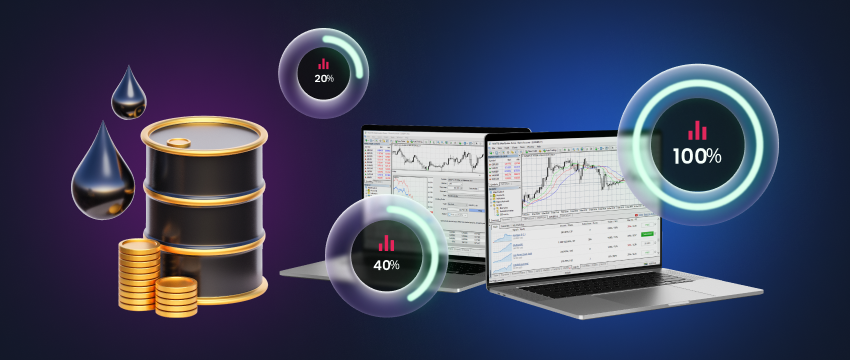Analysing financial market data is a critical step in identifying investment or trading opportunities. The process involves assessing various factors such as economic indicators, company fundamentals, and market trends. By leveraging available data and employing analytical techniques, investors can make informed decisions and potentially maximise their returns.
This article will provide a comprehensive guide on how to analyse financial market data for investment or trading opportunities. It will also cover important steps and tools for effective analysis.

Financial Market: Investment or trading goals
Before starting the process of analysing market data, it is imperative to establish clear goals. These goals will help you navigate the investment or trading landscape and determine appropriate trading strategies and risk tolerance. Whether the objective is short-term gains or long-term wealth accumulation, defining and understanding your goals ensures the analysis remains aligned with the desired outcomes.
Comprehensive data in the financial market
Collecting comprehensive and accurate data is critical for analysis to be effective. Traders or investors must refer to various sources like financial statements, economic reports or announcements, market news, geopolitical events, and industry-specific data. Key data points to gather may include:
- Historical price data
- Trading volumes
- 決算報告
- Balance sheets
- Cash flow statements
Other sources of vital data to assess the overall health of the economic environment are macroeconomic indicators like GDP growth, interest rates, inflation rates, and employment rates.
Technical analysis
Technical analysis is a popular analysis tool among global traders. It focuses on price patterns, trends and trading volumes to predict future price movements. Technical analysis uses a range of popular techniques:
Chart analysis
This is the plotting of price data on charts and using a variety of indicators like support and resistance levels, moving averages, and trend lines to identify patterns and potential entry or exit points.
Volume analysis
This is the analysis of trading volumes to establish the strength of price movements and confirm trends.
Oscillators
This technical analysis tool uses indicators like RSI (relative strength index), MACD (moving average convergence divergence) and Stochastic Oscillator to assess overbought or oversold conditions and possible reversals.

移動平均
Moving averages are used to assess the market, identify trends or indicate when one is moving in an opposite direction.
Momentum indicators
Traders make use of momentum indicators to establish how strong or weak stock prices are. They do this by analysing the rate of change of prices instead of the actual price changes themselves.
Support and resistance levels
Support and resistance levels are used to establish a surplus of sellers (resistance) or buyers (support) in the market. The underlying notion is that supply and demand drive price movements.
Volatility indicators
Volatility indicators measure the volatility of a currency pair over a specific period. Commonly used volatility indicators are ATR (Average True Range), Bollinger Bands, Volatility Index, Standard Deviation, ADI (Average Directional Index), and RVI (Relative Volatility Index).
Fundamental analysis
Fundamental analysis looks at the intrinsic value of an asset. It does this by examining the underlying variables impacting its worth. Key components of fundamental analysis include economic analysis, company analysis and industry analysis. Fundamental analysts will look at data like income statements, balance sheets, and cash flow statements to help them understand the profitability of a company, its financial health, and its ability to generate revenue.
A trader or investor using fundamental analysis will also make use of financial ratios including price-to-earnings (P/E), price-to-sales (P/S), and debt-to-equity (D/E), to compare companies and industries to identify the value of stocks (undervalued vs overvalued).
A fundamental analyst may also look at qualitative factors like the management expertise of a business, industry dynamics, competitive advantages, and future growth aspects to acquire insights into a company’s potential for success.
Risk assessment
A vital part of analysing financial data is evaluating risk. Investors typically consider market-related and company-specific risks. They do this in different ways such as beta analysis which is the measure of a stock’s sensitivity to market movements by calculating its beta value. Beta is usually used in fundamental analysis to establish the volatility of a stock relative to the market.
Stress testing is another method used in which different market scenarios are simulated to understand their impact on investments, thereby providing insights into the downside risks. Portfolio diversification is a way to manage risk as it spreads investments across different asset classes, industries or geographical regions to reduce the impact of individual stock or industry volatilities.
In conclusion
Analysing financial market data is a crucial component of identifying investment opportunities and making informed trading decisions. Through thorough analysis, investors and traders can gain a comprehensive understanding of market idiosyncrasies, company fundamentals, and risk profiles. It is important to remember however that market analysis is a dynamic and ongoing process, requiring constant monitoring and tweaking based on fluctuating market conditions. Diligence and discipline are key.

Using a demo trading account to learn more about financial market analysis
A trader trading in the forex market should consider using a demo trading account to study different analysis tools and the impact they have in making trading decisions. A demo account offers a risk-free, simulated trading environment in which traders can open and close positions without putting their own money at risk. Traders can use the demo account to explore multiple analysis tools and practice applying them to determine a range of potential trading outcomes. A demo account through powerful broker T4Trade gives traders access to the widely popular MetaTrader 4 (MT4) trading platform.
Used by millions of traders worldwide, MT4 offers a stellar trading experience, regardless of expertise or trading style. T4Trade also gives traders access to an extensive pool of educational resources and trading tools to widen their scope of knowledge about forex trading, as well as current news and insights about the different financial markets.
The T4Trade Academy is a brilliant resource with webinars, podcasts, videos-on-demand and LiveTV delivering a wealth of trading-related data.
Trading with T4Trade
T4Trade is a global broker, offering brokers access to 300+ financial instruments across 6 asset classes. This includes forex, shares, futures, metals, commodities, and indices. With T4Trade, traders can buy or sell their favourite assets via CFDs and explore trading opportunities with flexible or fixed spreads. The broker also provides traders with fast execution of trades, flexible trading conditions, and security of funds.
A dynamic multilingual customer support team also provides global traders with top-tier customer support throughout their trading journey. In addition, T4Trade’s MT4 platform offers traders key trading tools and features required to make optimal trading decisions.
Disclaimer: This material is for general informational & educational purposes only and should not be considered investment advice or an investment recommendation. T4Trade is not responsible for any data provided by third parties referenced or hyperlinked, in this communication.




